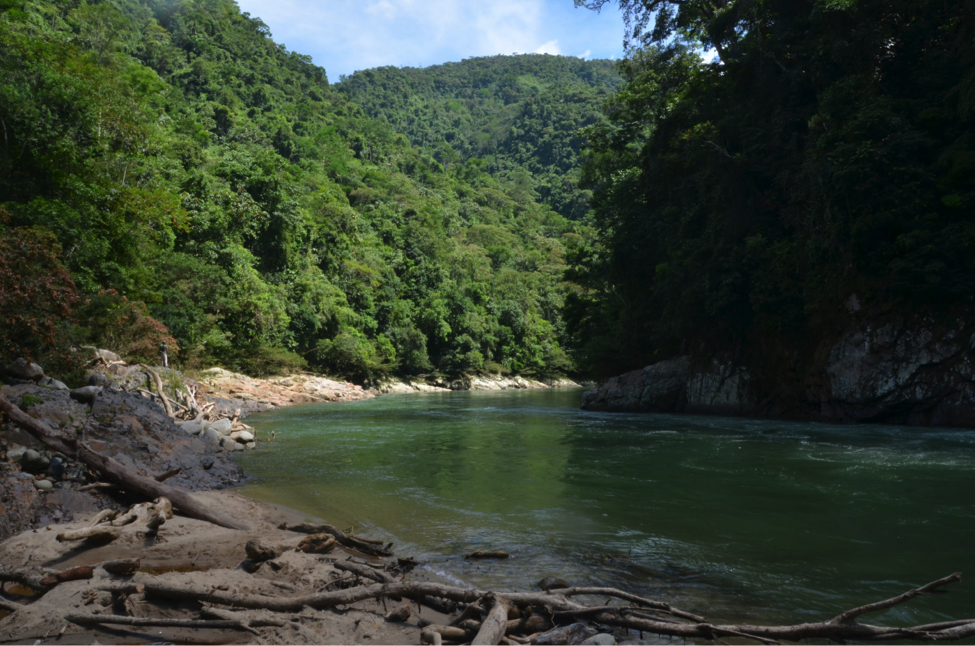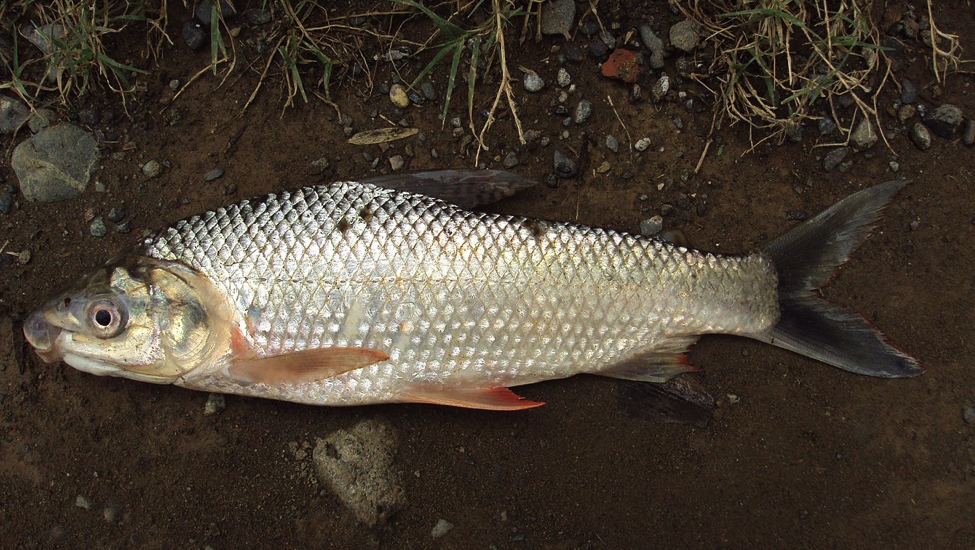- A proposed $800 million dam in northwestern Colombia would provide 352 megawatts of electricity annually.
- The dam is sited in the Samaná Norte River, which scientists are just starting to survey after being barred due to conflict. A recently discovered, critically endangered species of palm, Aiphanes argos, is highly threatened by the dam. Its discoverer says that flooding caused by dam construction could put the palm at high risk of extinction.
- Other critics say the dam may also displace local communities and reduce populations of a fish species important to the local economy. A dam expert says reduced water flow from damming the Samaná Norte could release more methane into the atmosphere.
- A representative from the company charged with construction of the dam says precautions will be taken to mitigate environmental damage.
PUERTO GARZA, Colombia – A Colombian conglomerate is moving ahead to build a nearly 400-foot-tall hydroelectric dam along the Samaná Norte River in northwestern Colombia, which threatens to extinguish critically endangered plant species found only in the canyon, and block the path of migrating fish.
Shrouded in violent conflict between guerrilla, paramilitaries and the state that displaced local farmers from their land for decades, the Samaná Norte River had been protected from development up until ten years ago, when the violence began to subside.
Local ecologists, taking advantage of recent peace in the area, are now exploring the canyon in in search of any rare, native species that may be hidden beside the emerald green waters and within the tropical forests hanging off the canyon’s steep walls.

The $800 million dam would provide 352 megawatts of electricity each year, representing 3 percent of Colombia’s annual electricity use.
While the environmental license for hydroelectric project Porvenir II has already been approved by the National Authority of Environmental Licenses (ANLA) and construction is expected to begin at the end of this year, environmental and social leaders continue to fight the dam project, which they say will cause irreparable environmental and social harm.
The opponents say endangered plant species that are endemic to this peculiar canyon ecosystem along the Samaná Norte River, situated between Medellin and Bogota, may disappear forever if the dam is built as planned.
Endangered palm
Expert local botanist Rodrigo Bernal, who is renowned for his work studying palms, has explored Rio Samaná Norte several times, accessing the area from the river to collect plant specimens along the river’s shores.
According to Bernal, the Samana Norte River canyon is home to a one-of-a-kind ecosystem that provides habitat for various endemic species.
“The canyon is very deep with very steep sides that has favored the development of a exclusive flora,” Bernal said. “It’s difficult for a seed to leave this canyon and start growing anywhere else.”
Furthermore, Bernal explained that the canyon is composed of marble with calcium carbonate deposits that dissolves in water, forming a karst environment along the rocky shores full of caves, pools and distinctive-looking cracks.
Bernal’s focus is on finding new rheophyte species, which are specialized plants adapted to growing along rocky shores and in rock cracks near fast-moving bodies of water.
These plants evolved “to resist the pounding water, holding onto the smallest cracks with their wide roots systems,” Bernal said. “To survive, their leaves are narrow and hydrodynamic.”
Last year, Bernal and his team discovered a new endangered species of rheophytic palm, which has only been found in the canyon. The team officially named the new palm Aiphanes argos after the investor group that will ultimately profit from the dam Porvenir II.

Aiphanes argos is one of the few rheophytic members of the palm family, and is endemic to a small area in the Samaná Norte River. Bernal said that the A. argos is included on the IUCN Red List as a Critically Endangered species because its population is highly threatened by the damming of the river for the hydroelectric plant. According to A. argos’ IUCN assessment, which Bernal coauthored, the planned dam “puts this species at extreme risk of extinction within a very short period of time.”
Mauricio Meza Porvenir II project leader at Celsia, who will be building the dam project, told Mongabay that the company is “obligated to relocate” A. argos and any other endangered plant species found in the canyon.
Meza also contends that A. argos is found elsewhere, which he said was “great news…we will be able to relocate them to other areas nearby.”
However, Bernal said that of the estimated 600 A. argos individuals identified along the river and surrounding tributaries, 80 to 85 percent would be submerged in the event that the dam is built. That would mean that potentially fewer than 100 A. argos palms would be left in their native habitat following the flooding of the canyon.
“If the majority of the plant’s population is destroyed, the species’ survival becomes extremely difficult,” Bernal said. “Any little change or disease would have the potential to extinguish the [Aiphanes argos palm] forever.”

This past month, Bernal returned to the Semaná River, to conduct a more comprehensive survey of rheophytic species.
The expedition team, which is called Extreme Botany due to the adrenaline-pumping way it conducts surveys via river rafts, collected 40 different rheophytic specimens. The researchers said they expect 9 or 10 to be new species — although they are still waiting for confirmation from experts in the different plant groups.
Bernal explains that these rheophytic species are adapted to grow in “extreme situations” of the Samana Norte River, such as heavy flash flooding, and that reproducing them at different altitudes and in new habitat conditions would not be an easy task.
“If the canyon is flooded, there is little guarantee that [the rheophytes] could survive in another ecosystem,” Bernal said. ‘What we do know, however, is that these plants will be the first to drown when the dam is built.”
Changing an ecosystem and a way of life
In addition to concerns for the endangered plants, critics say the dam would bring significant changes to the ways of life of the many people who live around it.
Communities along the shores depend on fishing in the Norte Samana. While there are many species such as catfish and freshwater herring, the bocachico is one of the most prized catches for locals.
The bocachico (Prochilodus magdalenae) is endemic to Colombia. Each year they migrate upstream from the Magdalena lowland swamps to fast moving tributary waters high in the Andes Mountains.
Many families in the village of Puerto Garza depend on the bocachico. In January, residents celebrate this intrepid fish and its contribution to the local ecosystem and economy with the Fiesta del Bocachico.

Alfonso Giraldo, a member of the Puerto Garza community who gave a television interview to Teleantioquia, said that the Puerto Garza residents are afraid that the large dam Porvenir II would stop the bocachico from migrating upstream and deprive them of an invaluable means of sustenance.
“The fear is that with the dam and the reservoir, the fish will disappear,” Giraldo said. “For many people here, we see it as bad, something irreversible.”
Celsia’s Meza said that as part of the environmental license they were granted, the company must monitor the river for wildlife passing through for the first year of construction. Once the dam is built, the company would stock the river above the dam.
Dams: clean renewable electricity?
Celsia argues that Colombia needs to build Porvenir II in order to meet the country’s growing demand for electricity, which the U.S. Department of Commerce projects will continue to rise at a 4.3 percent annual growth rate over the next 12 years.
According to U.S. Department of Commerce, large hydroelectric accounts for 66 percent of Colombia’s electricity generation, while gas and coal plants make up another 29 percent. The remaining 4-5 percent is comprised of small hydro and biomass plants.
Meza said that the dam offers an “efficient way to take advantage of natural geography,” and that Colombia’s other forms of electricity generation such as coal and gas “could be more contaminating.”

Limnologist and biogeochemist researcher at University of Quebec at Montreal Tonya DelSontro studies the dynamics of the methane in freshwater. DelSontro explained that while it’s true hydroelectric plants are more efficient than coal or gas, they “can’t be placed with wind or solar” as a fully climate-friendly source of electricity generation.
DelSontro explained that when a large dam is built and the river is widened into a reservoir, the flow of sediments and carbon downstream is stopped, creating “methane bubbling hotspots.”
Methane is a highly potent form of greenhouse gas, which causes the climate to heat up at a much faster rate than its better-known climate change accomplice, carbon dioxide. According to the Intergovernmental Panel on Climate Change, methane will be 86 times more efficient than CO2 at trapping heat over the next 20 years.
While all bodies of water leave a limited amount of methane in the atmosphere, DelSontro said “there is a particular fear that large dams in the tropics will be big emitters of methane.”
Colombia may already be experiencing the effects of climate change. Earlier this year when torrential rainfall killed at least 328 people and wiped out entire neighborhoods in the southern city of Mocoa, Environment Minister Luis Gilberto Murillo told Reuters that the country “is very vulnerable to phenomena of extreme climate variability and climate change.”
The family of San Luis municipality councilman Arnulfo Berrio has lived near the Samana river for at least two generations, with both his father and grandfather supporting the family with fish catch from the river.
Berrio said that Porvenir II was not worth the cost of damaging the river and its surrounding ecosystem when there is so much potential for solar or wind generation in other parts of the country. Berrio is also concerned about displacement of families that lived in near the dam site and are just now returning to their land after fleeing civil conflict in the 1980s and 1990s.
Instead of a dam, Berrio would like to see the country take a more community-friendly approach by helping to develop ecotourism along the banks of the “beautiful natural jewel” found within the Norte Samana river canyon.
“[Celsia] says this project won’t displace people from the their land, but it will,” Berrio said. “The hydroelectric dam isn’t development for the community I represent, but rather a degradation of our natural resources.”
FEEDBACK: Use this form to send a message to the editor of this post. If you want to post a public comment, you can do that at the bottom of the page.